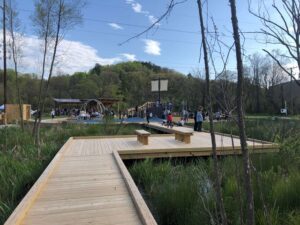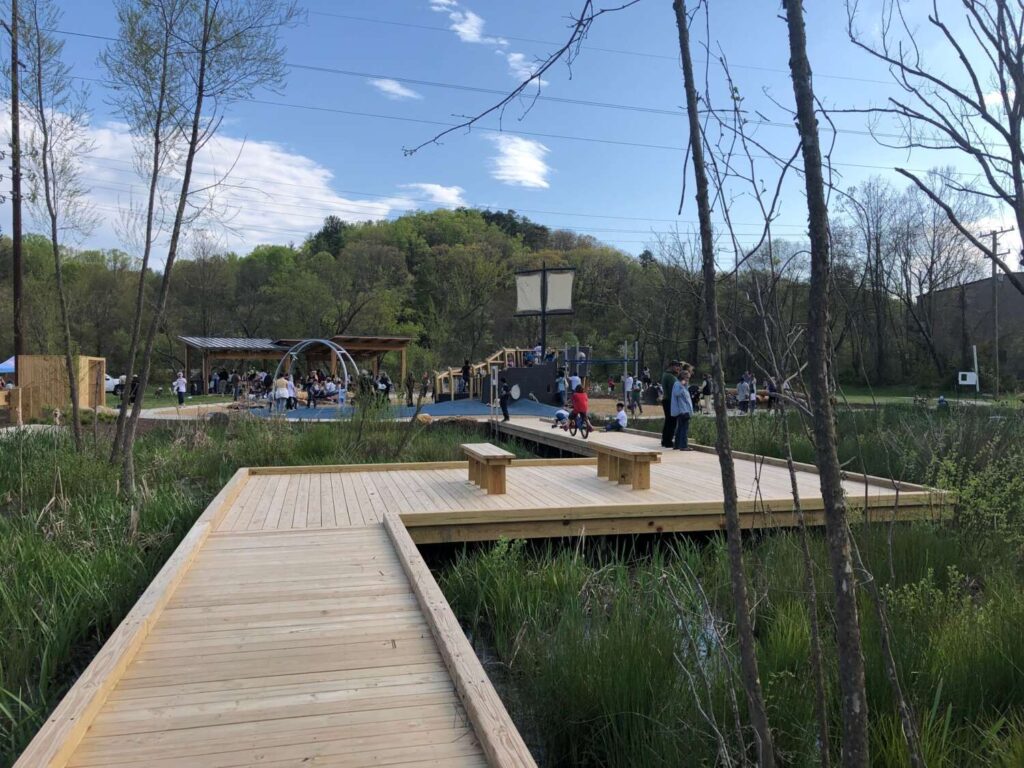Parks and other public spaces are hubs for recreation, gathering, socializing, and providing opportunities to strengthen communities.
They can also serve to provide greater resilience within our communities. Sustainably designed and built parks can provide refuge for a community.
As part of the planning process for designing a park, a list of program elements, or key amenities, is typically developed that meet the desires and needs of the public. These are then incorporated into the design and the construction of a park.
However, many park projects are located along a river or other body of water as these are often more challenging places for other types of development. Based on the location of these parks, they offer great opportunities to provide resilience from flooding that has increased due to more impervious surfaces and climate change. But planning for resilience can be more than just protection against floods.
Designing for resilience
There are several ways a park can be designed with resilience in mind. When utilizing green infrastructure as a means for building resilience, there are many community goals that can be met, providing for social, economic, and environmental resilience.
Looking at design with these synergies in mind takes creative planning. Identifying the natural assets that provide a function such as storage during rain events is one example of the planning process. Natural features should be identified as key elements to integrate into a park design.
Next, planning for stormwater design that goes beyond the basic requirements is another innovative idea when designing for resilience because stormwater standards are usually set as a baseline for design and approvals and not a gold standard.
Then, it’s the design itself. The site engineering that integrates the park amenities with the existing topography and drainage patterns can provide for a sustainably constructed park.
When all these work together, a park can be designed for resilience.
This doesn’t mean the park will not flood. On the contrary, the park is planned for flooding and is carefully designed so that the flooding does not cause considerable damage to the park. The design allows flood waters to have a place to go, it provides storage and treatment of stormwater runoff, and hopefully allows for faster recovery after a significant storm event, leaving a community hub as a place to gather once again.
As alluded to in the above paragraph, the green infrastructure components of a park can be a large part of building a park’s resilience as they serve many functions.
Innovative green infrastructure
Green infrastructure can replace or complement traditional piped water drainage systems. Vegetation, soils, and natural processes capture and infiltrate or evaporate water before it enters the piped system or natural water systems.
Green infrastructure can help reduce flooding and water pollution by absorbing and filtering stormwater. It simultaneously provides a natural relief to the built environment, improves the development aesthetic, and delivers social and health benefits to the community.
Looking beyond just treating stormwater, innovative green infrastructure considers:
- A systems approach to planning, design and implementation
- Synergies with other community goals
- Climate change and increased storm intensities, such as in cloudbursts
- Site-specific demands that may not fit into a predetermined Stormwater-Control Measure design
This approach to development is more challenging than traditional grey infrastructure and even standard green infrastructure approaches as it takes planning and site analysis from multiple disciplines working together to paint a holistic picture of the development site and the setting in which it exists.
The result is certainly worth the effort as it solves more than one problem, meets more than one goal, and is built to last.
Woodfin Greenway & Blueway projects

View from Silver-Line Park boardwalk over wetland toward the playground. Photo courtesy of Equinox.
As an example of resilience put into action, the Town of Woodfin is developing two parks as part of its Woodfin Greenway & Blueway project. Riverside Park is currently being designed for resilience as a regional park, and Silver-Line Park opened in the spring of 2022 as a community park.
In this article we focus on one development in particular: Silver-Line Park.
Silver-Line Park, which held its grand opening in April 2022, is one of these two parks located along the bank of the French Broad River. The park features river access, a nature-based playground, a train platform for leisure trips provided by Craggy Mountain Railway, and a constructed wetland.
The Town of Woodfin was looking for a park to meet the growing demands of the community. Goals identified through a public process included creating open space, a space for play, and a space for interpretation. Other municipal goals included treating stormwater prior to its release into the French Broad and building a park resilient to high-intensity storm events and flooding.
Site analysis and investigation
Early site investigations revealed the site to be a place of dumped construction debris and the previous home of a trailer park with remnant concrete pads.
The presence of a wetland in poor condition was also discovered on site. This, in and of itself, provided design challenges, but also spurred questions and creative design.
What is causing the water to pool here? Will the wetland dry up if stormwater is funneled elsewhere?
Taking a systems approach to design and considering the site-specific conditions and constraints, it was determined that cleaning up and expanding the wetland, rather than simply working around it or removing it all together, would meet many goals of the project.
Design
The wetland at Silver-Line Park became a critical feature of an adaptable and resilient park.
It became a place to treat stormwater runoff, mitigate flooding events, provide habitat, and an opportunity for interpretation.
To be sure the existing wetland is not further stressed, constructed wetlands receive the stormwater first, providing water storage and cleaning prior to the water working its way to the existing resource.
From the stormwater design utilizing green infrastructure, the rest of the park design fell into place, connecting open space, play and interpretation into a design that is resilient. The design of the wetland, now as a park feature, serves as:
- A recreation amenity
- An educational opportunity
- Habitat creation
- Flood storage
- Improved water quality to the French Broad
These synergies in design met many of the communities’ goals and set the stage for community members to take ownership of a park built to last.
A Park Open to the Public
In its first few months open, the park is already well used and loved.
The wetland is a central feature that draws people to it and through it.
Kids peer over the boardwalk counting tadpoles, adults chat while sitting on the landscape boulders, and several species of aquatic life and birds have found it and now call it home.
Like other great parks, this park has the foundation to be a hub for recreation, gathering, socializing, and providing opportunities to strengthen Woodfin and weather the storms to come.
Jason is a landscape architect specializing in innovative stormwater and park design. He understands the value of conducting landscape performance so that we can learn from our designs. He has spoken at the local, state, and national level on the impact of parks on social interaction and community building. Connect with Jason at equinoxenvironmental.com.
You can also view this article as it was originally published on page 30 of the 2022-23 edition of the directory.


